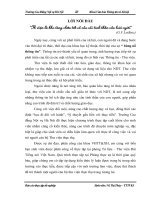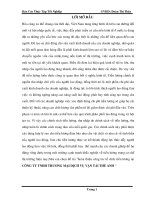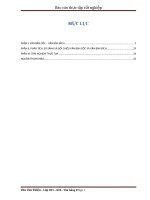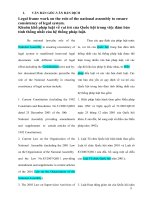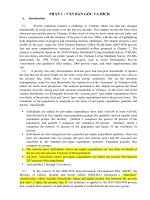Báo cáo thực tập tốt nghiệp tiếng anh (22)
Bạn đang xem bản rút gọn của tài liệu. Xem và tải ngay bản đầy đủ của tài liệu tại đây (137.15 KB, 12 trang )
Some analysts compare problems in Vietnamese and English in the
fields of science
PART I: INTRODUCTION
I.1 The reason chooses topics
Comparison regardless of language and spatial boundaries of language comparison. You
can compare the language of the countries of adjacent, on the same territory or in other regions in
the world.
Vietnamese scientists started to develop when the country opened in phases and
development when Vietnam approach to industrialization, modernization and global integration.
Integration process requires the development language (foreign language and native language) for
international exchange and technology transfer.
According to some research, although the directions for language education in the field of
science is unclear, but there were also reports at scientific conferences and scientific seminars on
language as Conference "Youth Language", 2002, 2003, 2004, Training Workshop Graduate School
- DHNN - Hanoi National University, 2002, the Conference on Language and Culture in Hanoi, Ho
Chi Minh City, etc. We I found that in a few years there have been many research projects on
scientific language is presented in the form of scientific reports, graduate theses, doctoral
dissertation.
Vietnamese language studies in the fields of science began with the remarkable step of
initiating the work and materials science is translated into Vietnamese from different languages
began to be the subject of linguists when referring to analyze and compare language.
I.2 Aims of the study
In the course of writing the grammar of scientific language indispensable participation of
scientists to compare the languages. To compare the basic research methods of language learning is
used to identify and distinguish between similar structures, activities and the development of
language. This is especially important for the translated text, because if not master the principles of
language comparison, according to the translator to translate sentiment, especially in cases when
meeting complex syntactic structures magazine.
Now exist and develop methods for comparison in two dimensions. When comparing twodimensional language, always appear the characteristics of both languages for comparison.
Principles of two-way comparison enables the detection of all interference language, clarify
language signs may be detected when comparing one side of a first language, as well as Monday.
This principle requires comparing the language to be conducted on the basis of the same style
1
functions. The documents were analyzed for comparison need to belong to the same genre style
functions. The documents collated in this way is a document of telecommunications technology.
Before proceeding to compare languages, should define terms so that they express a
similar phenomena be reconciled in both languages, that is to establish the general characteristics for
comparison with the corresponding language phenomena. The language is described in terms that
contain different content can not be carried out against each other.
In the comparison below I present the similarities structure and semantics of the sentence
than the sentence structure in English writing and errors in the text to Vietnamese.
I.3 Limit the scale of research
I researched the sentence structure is often used in scientific texts translated from English
into Vietnamese, in particular documents translated “ general introduction of Telecommunication
theory” publisher youth.
A feature to note is affected by the use of sentences in scientific texts oversea as English,
French, Russian… so in recent years appear likely to use passive structure in scientific writing
Vietnamese, especially the translated text, which formerly entirely uncommon.
I.4 Methods of study
To do this thesis, I used the following methods:
·
Analyzing method: I used this method to analyze the data collected from this work.
·
Compare method: I used this method to compare the different of Vietnamese and English in
the fields of science.
PART II: CONTENT
2
II.1 Translation theoretical
II.1.1 What is translation?
Translation is the expression in another language( target language) of what has been
expressed in one language( source language ), preserving semantic and stylistic equivalencies.
( By Roger T. Bell)
The author continues and makes the problems of equivalence very plain: Text in different
languages can be equivalent in different degrees( fully or partially different), in respect of different
levels of presentation ( in respect of context, of semantics, of grammar, of lexis, ect.) and different
ranks ( word for word, phrase for phrase, sentence for sentence).
However, language are different from each other, they are different in form having different
codes and rules regulating the construction of grammatical stretch of language and these forms have
different meanings.
Faced by a text in a language, we are able to work out not only the meaning of each word
and sentence but also its communicative value, its place in time and space and information about the
participants involved in its production and reception. We might take, as a light- hearted model of the
questions we can ask of the text, the first verse of a short poem by Kipling.
I keep six honest serving men;
( They taught me all they knew);
Their names were What? And Why? And When?
And How? And Where? And Who?
What? Is the message contained in the text; the content of the signal.
Why? Orients us towards the intention of the sender, the purpose for which the text was
used.
When? Is concerned with the time of communication realized in the text and setting in its
historical context; contemporary or set in the recent or remote past or future.
Where? is concern with the place of communication, the physicallocation of the speech
event realized in the text.
How? Refers to the participants involved in the communication; the sender and receive.
"Translate is to communicate a text from one language (source) to another language
(target) a loyalty to the extent possible, both in content and in form." So , in terms of ideals, the only
change that the translator can do that is language, language that is used to convey the original
meaning you want to express, and translator main task is to use another language to convey all of
what was conveyed in other languages.
3
M. Fyodorov (1950)
Translation is rendering a written text into another language in a way that the author
intended the text.
( By Bui Tien Bao – Hanoi National University)
“ Translators are concerned with written texts. They render written texts from one language
into another language. Translators are required to translate texts which arrange from simple items
including birth certificates or driving licences to more complex written materials such as articles in
journals of various kinds, business contracts and legal documents.
Translations, by dictionary definition, consists of changing from one state or form
to another, to turn into one’s own or another’s language.
( The Merriam Webster Dictionary, 1974)
Translation is basically a change of form. When we speak of the form of a language, we are
referring to the actual words, phrases, sentences, paragraphs, ects. The forms are referred to as the
surface structure of a language. It is the structural part of language which is actually seen in print or
heard in speech.
In translation the form of the source language is replaced by the form of receptor/ target
language. This is done by going from the form of the first language to the form of the second
language by a way of semantic structure.
It is meaning that is being transferred and must be held constant. Only the form changes.
The form which the translation is made will be called the source language and the form into which it
is to be changed will be called the receptor language.
Translation, then, consists of studying the lexicon, grammatical structure, communication
situation, and cultural context of the source language text; analyzing it in order to determine its
meaning, and then reconstructing this the same meaning using the lexicon, grammatical structure
which are appropriate in the receptor language and its cultural context.
II.1.2. Translation process
Translation process means that the whole process a translator from a text or a source text to
target text. Translation process can be described as follows:
-Decoding the source text meaning
-Coded meaning or translated into the target language
When we translation a source language into target language we must mention the steps in a
translation project. Before beginning any actual translation, it is important to have in mind the total
translation project and what is involved in producing a good translation. Before on considers
beginning a translation project, there are a number of matter which need to be clearly understood by
all who will be involved. These can be summarized under four T’s- the texts, the target, the team,
and the tools. For some projects, there will be a weath of materials that can be used to help in
interpreting the source language text and in finding equivalents in the receptor language. Beside, we
4
can exegesis- used to refer to the process of discovering the meaning of the source language text
which is to be translates. After a careful analysis of the source language text, as indicate above, the
translator begins drafting piece by piece, section by section. The transfer results in the initial draft.
Next we must evaluation version. The translator will want to compare the translation with the source
text at several points during the translation process to be sure no additions, deletions or change of
information have crept in. after evaluation is done carefully, there will need to be a revised draft
made on the basic of the feedback received. Finally, the translator incorporates into the translated
text the suggestions made by the consultant, checks them again with mother tongue speakers to be
sure they are warranted, and makes any other minor changes which have come to his attention.
II.2 Introducing study
Before proceeding to compare languages, should define terms so that they express a
similar phenomena be reconciled in both languages, that is to establish the general characteristics for
comparison with the corresponding language phenomena. The language is described in terms that
contain different content can not be carried out against each other.
In the comparison below I present the similarities structure and semantics of the sentence
than the sentence structure in English writing and errors in the text to Vietnamese.
III. Some sentence structure translation from English into Vietnamese
semantically incorrect and correct the fault.
The book General Introduction of Telecommunication Theory publisher's youth that we
have chosen to study the scientific content and practical value. In the Vietnamese translation exist on
semantic errors, style and spelling.
III.1. Error terms, phrases and punctuation:
The sentence were translated into Vietnamese:
“ Sau đó ít lâu con người phát sinh ra tín hiệu bằng lửa có khả năng truyền đạt các thơng
tin có hiệu quả và nhanh chóng khi tới các vùng xa”.
Original English sentence:
“A little later, men invented the signal fire capable of transmitting messages effectively and
rapidly to distant places”. (tr.22)
To compare the definitions of terms “ Phát sinh” and “ Invented” that:
Phát sinh : dg. Start born, arise out (usually talking about something unpleasant). Resolving
conflicts arise. Problems arise. (Institute of Linguistics, Vietnamese Dictionary, NXB.Da Nang,
2003, tr.769).
5
Ex: The flu usually arise in early summer.
Invented: v. To discover, as by study or inquiry; to find out; to devise; to contrive or produce
for the first time; - applied commonly to the discovery of some serviceable mode, instrument, or
machine. ( New Oxford dictionary, 2001).
Thus, we can see that “ Invented” can not be translated “ Phát sinh” , which must be
translated as “ Tìm thấy” or “ Phát hiện” . In Vietnamese, the meaning of human existence is not
generated. These are terms similar in meaning and hard mistranslated.
To compare the signal phrase “ tín hiệu bằng lửa” with “ signal fire” showed that the
translated phrase is incorrect because the phrase is a “ signal fire” similar phrases in Vietnamese and
translated for use as “ lửa dùng làm dấu hiệu” (to signal , used as a signal).
In Vietnamese and English grammar, adverb of time is distinguished by a comma if it
begins a sentence to clarify meaning. So, when translated into Vietnamese, comma should be kept in
place. Thus, the need to correct sentence is:
Sau đó ít lâu, con người đã tìm ra lửa dùng làm tín hiệu có khả năng truyền đạt các thơng
tin có hiệu quả và nhanh chóng tới các vùng xa”.
“
In the sentence above, I think, to sentences short and easy to get over, can not use “ cac”:
“ Sau đó ít lâu, con người đã tìm ra lửa dùng làm tín hiệu có khả năng truyền đạt thơng tin
có hiệu quả và nhanh chóng tới các vùng xa”.
III. 2. Semantic errors in a sentence:
The sentence were translated into Vietnamese:
“ Đồng thời việc xác minh này đã đưa ra các dịch vụ đưa thư và thông báo”. (tr.25)
Original English sentence:
“Also, this invention started the messenger and mail services”. (tr.24)
Comparison shows that “ Started” could not translated “ đã đưa ra” but you can translated “ đã bắt
đầu”, “ là khởi nguồn của”.
6
Comparison also shows that from “ messenger” have means “ thong báo” that is not true, which is
translated “ đưa tin”.
Thus, the need to correct sentence is:
“Đồng thời việc xác minh này đã bắt đầu các dịch vụ đưa thư và đưa tin”.
The sentence above, but is consistent with thinking and how to manipulate the Vietnamese language,
because it could: start a phenomenon (The invention began to be widely disseminated.), Which is
not : a phenomenon that started such a process above sentence. Thus, English sentences can be
translated as follows:
“ Đồng thời việc xác minh này là khởi nguồn của các hoạt động dịch vụ đưa thư và đưa tin”.
III.3. Mean error from the transplant and punctuation:
The sentence translated into Vietnamese:
“ Trong thế kỉ 21, việc phát triển áp dụng có tính thực tế về công nghệ liên quan đang tiếp
tục phát triển nhanh chóng và trong q trình đó, cách mạng hóa thế giới chúng ta”. (tr.25)
Original English sentence:
“In the XXI century, the development and practical applications of related technology have
continued to accelerate and, in the process, revolutionized our world”. (tr.24)
Comparison showed that the phrase “ Development” and “ Practical applications” includes the word
“ Development” and a separate group from “ Practical applications” are connected by “ and” is
determined by the article determine “ the”. Similarity of phrase in Vietnamese is “ Sự phát triển và
ứng dụng thực tế”.
Meaning from comparison also showed the “ Development and applications” have the same root
verb meaning “ Develop” and “ apply”. So, when translated into Vietnamese, this phrase can be
translated in the form of structure V - O (predicate - adverb.) This is one of the structural similarity
English - Vietnamese.
Phrases “ in the process” between the two commas are no longer retains the original meaning, which
becomes idiom, and similar expressions in Vietnamese is “ cùng lúc” . In this case, the word “ đêm”
in the Vietnamese must also be separated by two commas as in English.
Thus, the sentence should be modified as follows:
7
“ Trong thế kỉ 21, việc phát triển và ứng dụng thực tế các công nghệ liên quan tiếp tục tăng tốc và,
cùng lúc, cách mạng hóa thế giới chúng ta”.
III. 4. Other types of errors:
III.4.1. Grammatical errors:
The sentence were translated into Vietnamese:
“ Sau chiến tranh, nhu cầu về các hệ tổng đài có khả năng xử lí các cuộc gọi đường dài tự
động nhanh chóng đã tăng lên”. (tr.33)
Original English sentence:
“ After the war, the demand for switching systems capable of processing toll calls
automatically and rapidly was increased”. (tr.32)
In English, the adverbial phrase is distinguished by the greatest suffix -ly and verbs and adverbs. In
Vietnamese, the adverbial phrase can be distinguished from a more way . In case the reader easy to
misunderstand, the above structure should be translated as:
“ Sau chiến tranh, nhu cầu về các hệ tổng đài có khả năng tự động và nhanh chóng xử lí
các cuộc gọi đường dài đã tăng lên”.
Or :
“ Sau chiến tranh, nhu cầu về các hệ tổng đài có khả năng xử lí một cách tự động và
nhanh chóng các cuộc gọi đường dài đã tăng lên”.
III.4.2. Shift error structure:
The sentence were translated into Vietnamese:
“ Một kết quả không may mắn là nhiều sự khác biệt của khn khổ tín hiệu điều khiển và
thủ tục tiến hành” . (tr.173)
Original English sentence:
“An unfortunate result was that many varieties of control signal format and procedures
evolved”. (tr.172)
8
Sentence structure is one of the structural features of Vietnamese scientific documents, but as a
structure that is similar in structure in English. Sentence to be translated as follows:
“ Một điều khơng may là có sự tiến triển của nhiều loại quy trình và dạng thức tín hiệu điều
khiển”.
III.4.3. Error structural shift "Both ... and ..."
The sentence were translated into Vietnamese:
“ Khuôn khổ điều khiển phụ thuộc vào bản chất của cả hai hệ thống truyền dẫn và thiết bị
đầu cuối của chúng”. (tr.173)
Original English sentence:
“ The control formats depend on the nature of both the transmission system and its
terminal equipment”. (tr.172)
“ Both” the English equivalent of “ cả…và…” , “ cả…và cả…”. In this case, both can not
be translated “ cả hai…và…” Because the structure of the Vietnamese language is not equivalent
with “ both” in the English. Therefore, the sentence to be translated as follows:
“ Các dạng thức điều khiển phụ thuộc vào bản chất của cả hệ thống truyền dẫn và thiết bị
đầu cuối của chúng”.
Or:
“ Các dạng thức điều khiển phụ thuộc vào bản chất của cả hệ thống truyền dẫn và cả
thiết bị đầu cuối của chúng”.
Or:
“ Các dạng thức điều khiển phụ thuộc vào bản chất của cả hai: hệ thống truyền dẫn và
thiết bị đầu cuối của chúng”.
III.4.4. Shift error component structure:
The sentence were translated into Vietnamese:
“ Ngoài ra, để thực hiện chuyển mạch phân chia thời gian có thể dùng các chuyển mạch
thời gian để trao đổi khe thời gian và chuyển mạch phân chia thời gian để trao đổi theo không gian
các khe thời gian được phân chia theo thời gian”. (tr.45)
9
Original English sentence:
“ In addition, for realization of time division switching, time switches for exchanging time
slot and time-shared division switches for exchanging spatially the time divided time slots are
available”. (tr.44)
Sentence to be corrected as follows:
“ Ngoài ra, để thực hiện chuyển mạch phân chia thời gian, có thể dùng các chuyển mạch thời gian
để trao đổi khe thời gian và dùng chuyển mạch phân chia thời gian để trao đổi theo không gian các
khe thời gian được phân chia theo thời gian”.
10
PART III: CONCLUSION
In all my research has raised some issues in the process of translation work “ General
Introduction of Telecommunication Theory” of publisher youth encounter in the process of
translation from source text ( English) to target text ( Vietnamese).
According to above study, we can understand once more that to translate and a text from
the source language ( English) into the target language ( Vietnamese). Beside we can know some
problem when translated a work in the fields of science. There are many difference when translation
English into Vietnamese that translators need understand to get the best translation because
Vietnamese is very diverse and rich as well as lexical category.
So I hope that after reading and understanding all of my reseach you will understand more
about how to translate, wording to match when translating a scientific text in English into
Vietnamese.
11
PART I: INTRODUCTION
I.1 The reason chooses topics................................................................................1
I.2 Aims of the study..............................................................................................1
I.3 Limit the scale of research...............................................................................2
I.4 Methods of study..............................................................................................2
PART II: CONTENT
II.1 Translation theoretical...................................................................................3
II.1.1 What is translation?.....................................................................3
II.1.2. Translation process......................................................................4
II.2 Introducing study...........................................................................................5
III. Some sentence structure translation from English into Vietnamese
semantically incorrect and correct the fault...............................................5
III.1. Error terms, phrases and punctuation..........................................5
III.2. Semantic errors in a sentence........................................................6
III.3. Mean error from the transplant and punctuation.......................7
III.4. Other types of errors......................................................................8
III.4.1. Grammatical errors.......................................................8
III.4.2. Shift error structure......................................................8
III.4.3. Error structural shift "Both ... and ..."........................9
III.4.4. Shift error component structure...................................9
PART III: CONCLUSION
12



